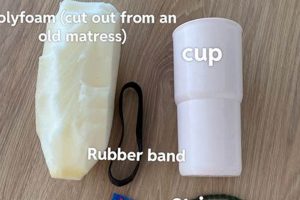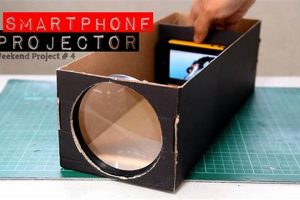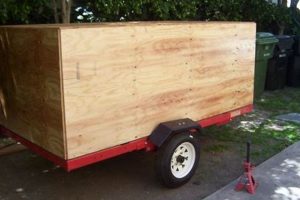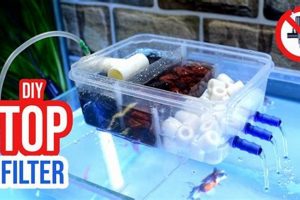The creation of a customized writing surface using readily available materials allows for dynamic communication and planning. Such a project typically involves repurposing common items and applying a specific coating that permits repeated marking and erasing. An example includes using a sheet of melamine or applying specialized paint to a smooth surface.
This form of crafting offers numerous advantages, including cost savings, personalization, and environmental consciousness through material reuse. Historically, similar methods were employed to create temporary writing surfaces before the mass production of commercially available whiteboards, providing accessible alternatives for educational and organizational needs.
The subsequent sections will detail practical approaches to constructing such a surface, outlining necessary materials, preparation techniques, and application methods to achieve a functional and aesthetically pleasing result. This includes examining various coating options, substrate choices, and framing considerations for optimal performance.
Construction Tips for a Customizable Writing Surface
The following recommendations aim to optimize the creation and performance of a customized writing surface, ensuring longevity and functionality.
Tip 1: Substrate Selection: Choose a non-porous material like melamine or acrylic for the base. Porous surfaces will absorb ink, hindering erasability.
Tip 2: Surface Preparation: Thoroughly clean and lightly sand the chosen substrate. This ensures proper adhesion of the coating and a smooth writing surface.
Tip 3: Coating Application: Apply multiple thin coats of specialized dry-erase paint or laminate, allowing each coat to dry completely. Thick, uneven coats can result in cracking and poor erasability.
Tip 4: Curing Time: Allow the finished surface to cure for the manufacturer-recommended time period before use. Premature use can damage the coating and affect its erasability.
Tip 5: Marker Selection: Use only markers specifically designed for dry-erase surfaces. Permanent markers will damage the surface irreparably.
Tip 6: Cleaning Practices: Regularly clean the surface with a microfiber cloth and dry-erase cleaner to prevent ink buildup and ghosting.
Tip 7: Framing Considerations: Consider adding a frame to protect the edges of the surface and provide a finished look. Ensure the frame does not interfere with the writing area.
Adhering to these guidelines will contribute significantly to the creation of a durable and highly functional customized writing surface suitable for various applications.
The subsequent concluding remarks will summarize the critical aspects of this construction method and reiterate its value in diverse settings.
1. Surface material selection
Surface material selection represents a foundational decision in the construction of a customized writing surface. The choice of material directly influences the erasability, durability, and overall functionality of the finished board, impacting its long-term utility.
- Melamine Composition and Performance
Melamine, a common laminate, offers a smooth, non-porous surface conducive to dry-erase marking. Its rigid structure resists warping and provides a stable writing platform. However, lower grades of melamine may exhibit less effective erasability over extended periods, necessitating regular cleaning to prevent ink residue accumulation. Its cost-effectiveness makes it a frequently chosen option.
- Acrylic Alternatives and Enhanced Durability
Acrylic sheets present an alternative possessing superior durability and enhanced erasability compared to standard melamine. The non-porous nature of acrylic minimizes ink absorption, facilitating cleaner and more efficient erasing. While generally more expensive, the investment yields a surface that withstands frequent use and resists staining, particularly valuable in high-traffic environments like classrooms or offices.
- Glass Considerations for Premium Surfaces
Tempered glass provides the highest level of erasability and resistance to ghosting. Its smooth, non-reactive surface ensures complete ink removal without staining or scratching. However, glass is a heavier and more fragile material than melamine or acrylic, requiring careful handling and secure mounting. The increased cost and installation complexity make it a premium choice suitable for applications demanding exceptional performance and longevity.
- Repurposed Materials and Surface Suitability
The concept extends to repurposing existing materials, such as smooth, non-porous tabletops or cabinet doors. Evaluation of the existing finish is crucial; a gloss or semi-gloss paint provides a base upon which to apply a dry-erase coating. Thorough cleaning and preparation of the surface are vital to ensure adequate adhesion of the dry-erase coating. This approach offers a cost-effective and environmentally conscious alternative.
The selection of a suitable surface material forms the cornerstone of a successful “do-it-yourself” writing surface project. Carefully weighing the factors of cost, durability, erasability, and potential for repurposing existing resources enables the creation of a functional and personalized communication tool.
2. Coating application technique
The effectiveness of a self-constructed writing surface is intrinsically linked to the coating application technique employed. Improper application directly impacts the erasability and overall lifespan of the board. A poorly applied coating, characterized by uneven thickness, insufficient curing, or contamination, results in a surface prone to ghosting, scratching, and premature degradation. For instance, applying a single, thick layer of dry-erase paint often leads to cracking during the curing process, rendering the surface unusable. Conversely, meticulous application of multiple thin layers, each allowed to fully cure, promotes a smooth, durable finish capable of withstanding frequent use and cleaning.
The practical significance of understanding optimal coating application is evident in the resulting usability of the board. Achieving a uniform surface devoid of imperfections requires careful surface preparation, including sanding and cleaning, prior to coating. Selection of appropriate application tools, such as foam rollers or spray guns, further contributes to a consistent finish. Post-application, adherence to the manufacturer’s recommended curing time is crucial. Failure to comply with these guidelines undermines the integrity of the coating, leading to subpar performance. Consider the scenario of a classroom where a hastily constructed writing surface, lacking proper coating application, quickly becomes unusable due t
o persistent marker residue and surface damage, thus hindering the educational process.
In summary, the coating application technique represents a critical determinant of the success of a “do-it-yourself” writing surface. Rigorous adherence to best practices, encompassing surface preparation, application method, and curing protocols, ensures a functional and durable product. Challenges associated with achieving a flawless finish can be mitigated through careful planning, meticulous execution, and a thorough understanding of the materials involved. Neglecting this crucial aspect compromises the utility and longevity of the board, ultimately negating the benefits of the self-construction process.
3. Marker compatibility
Marker compatibility is a critical determinant of the usability and longevity of a “do-it-yourself” writing surface. The interaction between the marker ink and the board’s surface directly affects erasability, ghosting, and potential surface damage. Incompatible markers can render the board unusable, negating the cost and effort invested in its creation.
- Solvent-Based vs. Water-Based Markers
Dry-erase markers typically employ either a solvent-based or water-based ink formulation. Solvent-based markers, while offering vibrant colors, can be more prone to ghosting and require stronger cleaning solutions for removal. Water-based markers generally erase more cleanly but may produce less intense colors and require more frequent reapplication. The surface coating must be compatible with the chosen ink base to ensure proper erasability and prevent permanent staining. Selecting the wrong type of marker will cause significant issues.
- Marker Tip Type and Surface Texture
The type of marker tipfine, medium, or broadinteracts differently with varying surface textures. A rough surface, even if coated with dry-erase paint, may cause fine-tipped markers to skip or produce inconsistent lines. Conversely, a very smooth surface may cause broad-tipped markers to bleed or produce overly thick lines. Matching the marker tip to the surface texture ensures optimal writing clarity and prevents premature wear on both the marker and the board.
- Ink Pigment and Ghosting Potential
The pigments used in dry-erase marker inks vary in their susceptibility to ghostingthe residual staining left behind after erasing. Some pigments bond more strongly to the surface coating, making them more difficult to remove completely. Regular cleaning with appropriate dry-erase cleaning solutions can mitigate ghosting, but the selection of markers with low-ghosting pigments is a proactive measure to maintain the board’s appearance and usability over time. Testing different brands for ghosting on your board is recommended.
- Permanent Markers and Surface Damage
The accidental use of permanent markers on a “do-it-yourself” writing surface poses a significant risk of irreversible damage. Permanent marker inks contain solvents and pigments that penetrate the dry-erase coating, bonding permanently to the underlying surface. While some removal techniques may reduce the visibility of permanent marker stains, complete restoration of the original surface is often impossible. Implementing clear labeling and storage practices can help prevent accidental use of permanent markers on the writing surface.
The careful consideration of marker compatibility is crucial for maximizing the lifespan and functionality of a “do-it-yourself” writing surface. Selecting appropriate markers, understanding their interactions with the surface coating, and implementing preventative measures against incompatible markers are essential for ensuring a long-lasting and usable writing tool.
4. Cleaning maintenance
The sustained usability of a self-constructed writing surface hinges significantly on consistent and appropriate cleaning maintenance. Neglecting this aspect leads to diminished erasability, ghosting, and ultimately, a compromised writing surface. Effective maintenance protocols are paramount to preserving the board’s functionality and appearance.
- Frequency of Cleaning and Erasability
The frequency with which a writing surface is cleaned directly affects its long-term erasability. Regular cleaning, ideally after each use, prevents ink from bonding permanently with the surface coating. Infrequent cleaning allows ink pigments to settle into microscopic pores, leading to ghosting and requiring more aggressive cleaning methods. A daily cleaning schedule, tailored to the board’s usage intensity, is recommended.
- Appropriate Cleaning Solutions and Surface Integrity
The selection of appropriate cleaning solutions is crucial to maintaining the integrity of the dry-erase surface. Harsh chemicals or abrasive cleaners can damage the coating, leading to scratches, discoloration, and reduced erasability. Specifically formulated dry-erase cleaners, or mild solutions of isopropyl alcohol, are recommended. Testing the cleaner on a small, inconspicuous area of the board prior to full application is advisable.
- Cleaning Tool Selection and Scratch Prevention
The tools used for cleaning also contribute to the board’s longevity. Abrasive cloths or scouring pads can scratch the surface, creating microscopic grooves that trap ink and impede erasability. Soft, lint-free microfiber cloths are ideal for removing ink residue without damaging the coating. Regular replacement of cleaning cloths ensures optimal cleanliness and minimizes the risk of scratching.
- Addressing Persistent Stains and Ghosting
Despite regular cleaning, some inks may leave behind persistent stains or ghosting. In such cases, specialized dry-erase stain removers or a paste of baking soda and water can be employed. Gentle application and thorough rinsing are essential to avoid damaging the surface coating. Prevention through regular cleaning and the use of high-quality markers remains the most effective strategy.
Effective cleaning maintenance is not merely an ancillary task but an integral component of ensuring the long-term viability and optimal performance of a “do-it-yourself” writing surface. Consistent application of appropriate cleaning methods and materials safeguards the investment of time and resources, resulting in a functional and aesthetically pleasing communication tool.
5. Framing optimization
Framing, in the context of a customized writing surface, extends beyond mere aesthetics; it directly influences structural integrity, longevity, and usability. The optimization of this element, therefore, is crucial for maximizing the return on investment and ensuring sustained functionality. A poorly executed frame can compromise the surface, leading to warping, cracking, or detachment. Conversely, a well-designed and properly installed frame reinforces the board, protects its edges from damage, and provides a professional, finished appearance. Consider, for example, a large-format writing surface constructed for use in a conference room. Without a robust frame, the expansive surface area is susceptible to bow
ing, rendering portions of the board unusable. A sturdy frame, however, mitigates this risk, maintaining a flat, consistent writing surface across the entire area.
The choice of framing materials and construction techniques significantly impacts the overall performance of the writing surface. Wood frames, while aesthetically pleasing, require careful sealing and finishing to prevent moisture absorption, which can lead to warping and delamination. Metal frames, such as aluminum, offer superior durability and resistance to environmental factors but may necessitate specialized tools and skills for fabrication and installation. Furthermore, the method of attaching the frame to the writing surface must be carefully considered. Screws, adhesives, and other fasteners must be appropriately sized and spaced to ensure a secure and lasting bond without compromising the writing surface itself. For instance, using excessively long screws can penetrate the writing surface, creating unsightly blemishes and potentially hindering erasability. Proper selection of materials prevents future issues.
In summary, framing optimization is an indispensable element in the successful creation of a “do-it-yourself” writing surface. By carefully selecting framing materials, employing appropriate construction techniques, and ensuring a secure and lasting attachment, one can significantly enhance the structural integrity, longevity, and overall usability of the board. Neglecting this aspect can result in a compromised writing surface, undermining the time and effort invested in its construction. Thus, the framing process merits careful consideration and execution to ensure a functional and aesthetically pleasing final product.
6. Size customization
The capacity to modify dimensions constitutes a central benefit of creating a writing surface independently. Commercial offerings present predetermined sizes, often unsuitable for specific spatial contexts or task requirements. A customized approach allows for the creation of a board precisely tailored to the available area and intended application. This adaptability enhances efficiency and utility, enabling the creation of writing surfaces optimized for diverse environments, from small home offices to expansive classroom settings. For example, a narrow alcove might accommodate a vertically oriented board, maximizing writing space without encroaching on the surrounding area, a solution not readily available through standard retail options.
The practical implications of size customization extend to specialized applications. Consider a project manager requiring a visual aid for tracking multiple project timelines. A commercially available whiteboard might lack the necessary dimensions to display all relevant information concurrently. A customized board, however, could be constructed with sufficient width and height to accommodate a comprehensive project schedule, enhancing team collaboration and project oversight. Similarly, in a manufacturing environment, a large, wall-mounted board could display critical production metrics, customized to fit the available wall space and provide readily accessible information to all personnel. This degree of specificity is a key advantage of this project.
In conclusion, size customization represents a significant value proposition in the construction of a writing surface. It allows for the creation of a tool perfectly matched to its intended environment and purpose, overcoming the limitations of standardized commercial products. The ability to tailor dimensions enhances usability, maximizes spatial efficiency, and supports specialized applications across various professional and domestic contexts. While challenges may arise in sourcing appropriately sized materials or adapting construction techniques, the benefits of a perfectly fitted writing surface often outweigh these considerations.
7. Mounting method
The method employed to mount a constructed writing surface is inextricably linked to its functionality, safety, and longevity. Inadequate mounting can lead to instability, damage to the board itself, and potential safety hazards. The choice of mounting method, therefore, is not a trivial detail but a crucial determinant of the project’s overall success. For instance, a large, heavy surface secured with insufficient fasteners is at risk of detaching from the wall, posing a threat of injury and rendering the board unusable. The mounting system must be chosen with careful consideration of the board’s size, weight, intended usage, and the composition of the wall to which it will be affixed. A light-weight board might be secured with adhesive strips, while a heavier board necessitates more robust hardware, such as screws and anchors, properly installed into wall studs.
The practical implications of selecting an appropriate mounting method extend beyond simple stability. The ease with which the board can be installed, removed, or repositioned is directly affected. A permanent mounting solution, while offering maximum security, limits flexibility and can damage the wall upon removal. A semi-permanent solution, such as a French cleat system, allows for easy removal and repositioning while still providing a secure attachment. Furthermore, the aesthetic integration of the board into the surrounding environment is influenced by the mounting method. Concealed mounting hardware provides a clean, minimalist look, while exposed hardware can contribute to an industrial aesthetic. Consider the scenario of a writing surface intended for use in a collaborative workspace. A mobile mounting system, such as a rolling stand, allows for easy relocation of the board to different areas within the space, facilitating dynamic brainstorming sessions and impromptu meetings.
In summary, the mounting method is a critical component in the realization of a functional and safe writing surface. The selection of an appropriate mounting solution, tailored to the specific characteristics of the board and the intended environment, is essential for maximizing its usability and longevity. Challenges associated with mounting can be mitigated through careful planning, thorough research, and the use of appropriate tools and materials. By prioritizing the mounting method as an integral part of the design process, one can ensure a successful project that provides a valuable and reliable communication tool for years to come.
Frequently Asked Questions about DIY Dry Erase Boards
This section addresses common inquiries and misconceptions regarding the construction and use of self-made writing surfaces. The information presented aims to clarify best practices and potential challenges.
Question 1: Is specialized paint absolutely necessary for a functional DIY dry erase board?
While specialized dry-erase paint offers the most reliable performance in terms of erasability and resistance to ghosting, certain alternatives may suffice for limited use. Applying multiple coats of a high-gloss, non-yellowing enamel paint can create a somewhat erasable surface, but the durability and erasability will not match that of dedicated dry-erase coatings. Regular cleaning is crucial to mitigate ghosting with such alternatives.
Question 2: What is the best way to prevent ghosting on a DIY dry erase board?
Preventing ghosting involves a combination of factors. First, selecting a non-porous surface material, such as melamine or glass, minimizes ink absorption. Second, applying mult
iple thin coats of a high-quality dry-erase coating ensures a smooth, protective layer. Third, regular cleaning with appropriate dry-erase cleaning solutions prevents ink build-up. Finally, using markers specifically designed for dry-erase surfaces and avoiding permanent markers is essential.
Question 3: Can any type of adhesive be used to attach a DIY dry erase board to a wall?
The choice of adhesive depends on the size and weight of the board, as well as the composition of the wall. Lightweight boards can be secured with strong adhesive strips, but heavier boards require mechanical fasteners, such as screws and anchors, for safety and stability. Ensure that the adhesive is compatible with both the board’s surface and the wall material to prevent damage or detachment.
Question 4: How long should a DIY dry erase board be allowed to cure before use?
The curing time depends on the specific dry-erase coating used and is typically specified by the manufacturer. Generally, allowing the coating to cure for at least 24-72 hours is recommended to ensure that it fully hardens and achieves optimal erasability. Premature use can damage the coating and affect its performance.
Question 5: Is it possible to repair a scratched or damaged DIY dry erase board?
Minor scratches can sometimes be buffed out with a soft cloth and a polishing compound specifically designed for the surface material. More significant damage may require re-coating the affected area or replacing the entire surface. Prevention through careful handling and regular maintenance is the best approach.
Question 6: Can repurposed materials be effectively used for DIY dry erase boards?
Repurposing materials, such as old tabletops or cabinet doors, can be a cost-effective and environmentally friendly approach. However, the surface must be thoroughly cleaned, sanded, and prepared before applying a dry-erase coating. Ensure that the existing finish is compatible with the coating and that the repurposed material is structurally sound and free of any defects that could compromise the board’s functionality.
In summary, creating a successful writing surface requires careful attention to material selection, application techniques, and maintenance practices. Addressing these frequently asked questions can help mitigate potential challenges and ensure a satisfactory outcome.
The subsequent section will provide concluding remarks, summarizing the key benefits and considerations associated with this endeavor.
DIY Dry Erase Board
The preceding exploration has detailed the processes and considerations inherent in the creation of a “diy dry erase board”. Key aspects discussed include material selection, coating application, marker compatibility, cleaning maintenance, framing optimization, size customization, and mounting method. Each element contributes critically to the functionality and longevity of the final product, requiring diligent attention to ensure optimal performance. The economic benefits, customization options, and potential for material repurposing offer compelling advantages over commercially manufactured alternatives.
The endeavor of constructing a writing surface represents a commitment to resourcefulness and precision. The information provided serves as a guide for informed decision-making and skillful execution. The enduring value of this project lies in its capacity to provide a tailored communication tool that meets specific needs and reflects a dedication to practical craftsmanship. Continued adherence to established maintenance protocols will further ensure the sustained utility of the finished board.







